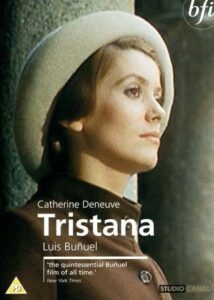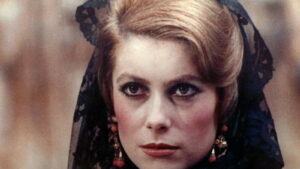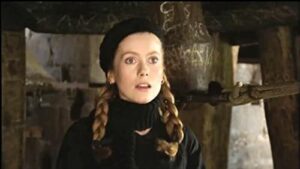“Tristana” – a Story of Lost Innocence

Title: “Tristana”
Release Date: 1970
Director: Luis Buñuel
Cast: Catherine Deneuve, Fernando Rey, Franco Nero, Lola Galos, Jesus Fernandez
“Tristana,” starring the phenomenal Catherine Deneuve, is a story of lost innocence set in the climate of Spanish Toledo. Using the narrative pattern of a young girl’s lust for a wealthy old man, Luis Buñuel rips off the masks of hypocrisy from both superficial religiosity and the ideology of libertinism. The condition for the operation of moral principles is true freedom, and all forms of its restriction lead to dangerous perversions – this is the credo of the Spanish director emerging from “Tristana”.
“Tristana” – once upon a time in Toledo
Luis Buñuel long carried around the plan to make “Tristana”. However, the creation of the film was prevented by the scandal surrounding his “Viridiana” (1961), which was read as a scandalous and blasphemous work. Several years after the aforementioned incident, however, the director managed to film a story about a beautiful, innocent girl, taken from a novel by Benito Perez Galdos. The movie’s plot begins in 1923 in Toledo. Tristana is a teenage girl who, after the death of her mother, is placed in the care of her uncle. Don Lope (Fernando Rey) takes advantage of the girl’s financial dependence and induces her to become his mistress. After a few years, the heroine meets a young, handsome painter Horacio (Franco Nero) during a walk and falls in love with him. Meanwhile, the uncle, who declares libertine views and is an enemy of the institution of marriage, becomes increasingly jealous and suspicious. Tristana decides to put everything on the line and run away with her chosen one to Madrid.
In 1930, nonetheless, the girl unexpectedly returns. It turns out that Tristana suffers from bone cancer, and don Lope, who two years earlier inherited his late sister’s estate, can help her. The girl recovers, but loses her leg. Meanwhile, Horacio leaves, and Tristana marries her uncle. When her husband suffers a seizure one night, the cold-blooded woman delays calling a doctor and watches his agony.
Buñuel’s “Tristan” and Galdos’ novel
Buñuel reached for Galdos’ novel not by accident, but at the same time made many significant changes in his adaptation compared to the original. In the works of this writer, the director was attracted primarily by the truly Spanish atmosphere, manifested in an accurate portrayal of the mentality and customs of the country. Buñuel modernized the reality, moving the action from the late 19th century to the late 1920s and early 1930s of the following century. He also changed the location of events from Madrid to Toledo, which gave the story an even more local, almost provincial dimension.

The most significant shift in the film adaptation of the book, meanwhile, was the change in the ending. In the novel version, Tristana and don Lope “live happily ever after” as a married couple. In Buñuel’s case, on the other hand, we have a finale that is crucial to the meaning of the entire film: it is the image of a calculating and spoiled to the marrow of her bones woman, taking revenge on the man who took her innocence.
“Tristana” and the unmasking of social hypocrisy
“Tristana” can be called the quintessence of Bunuel’s cinema. For here we have his Spanish roots, led by the austere religiosity and its other dark face, the climate from which the Spanish director’s work grows. We also have the characteristic leit-motiv of Buñuel’s cinematic world, i.e. the unmasking of social elites who hide the darkest perversions under the guise of good manners. Interestingly, it turns out that liberalism can be as convenient a mask as empty religiosity. Growing out of opposition to bourgeois hypocrisy, the rebellion against the institution of marriage here becomes a mere pose, underneath which lies a strong machismo and contemptuous attitude toward women. Don Lope, the hero who embodies the libertine type, is the embodiment of the hypocrite. While preaching the theses of free love, he is at the same time the one who forces sexual submission on the girl who depends on him, and then locks her in the house and out of jealousy forbids her even ordinary walks. He preaches his modern views, knowing that money is the only source of his power over young Tristana.
In addition, this great contortionist, when old age begins to take its toll on him, gives up the company of his original friends in favor of stopping with the clergy and marries Tristana, exchanging libertinism for comfortable clericalism.
“Tristana” – a story of defiled innocence
At the center of “Tristana,” however, is not a story about a man, but the story of a woman in the fetters of male power, which, regardless of the mask she chooses: patriarchal or libertine, invariably makes her an object. Indeed, the bonds of marriage are no less oppressive for the heroine than the apparent freedom from the institution of marriage. In either case, the woman here is an object completely dependent on the man, primarily materially. Freedom thus turns out to be an illusion, a rhetorical embellishment in the mouth of the aging libertine, hiding his immoral temptations. Sexual abuse by an elderly guardian leaves a deep mark on Tristan, which changes the innocent girl’s heart. Neither does her relationship with an, admittedly consciously chosen, but unstable in feelings man heal her. Catherine Deneuve remarkably evocatively portrayed this inner transformation of her heroine on the screen.

Nevertheless, Buñuel does not limit himself to this sad statement, but also reveals to the viewer the other face of this innocence. For it undoubtedly has the hallmarks of erotic obsession. Behind it lies not only self-interest, but also perversion. It is heralded by Tristana’s symbolic dreams of don Lupe’s severed head as the heart of a bell. The heroine twice dreams of such an image, which each time foreshadows a turning point in her life. The first is sexual initiation, marked by disgust with the old man; the second is her failure to help her dying husband. These two elements, sex and death, are here fused in a peculiar way. The sound of a bell traditionally announces something significant, like death – this is the case in Buñuel’s film, and twice: the first is the symbolic death of Tristana, whose innocence is irretrievably lost, the second – the physical agony of her uncle.
The suggestion of the heroine’s perverse tendencies, however, can be found already in the opening scenes of the film, when, together with the servant don Lupe, the girl visits her son at the school for the deaf. Saturno then receives an apple from Tristana, which can be read as a telling symbol of sinful delight. After all, the same boy will be, years later, the one before whom the heroine exposes herself in the window, satisfying her hidden desires.
“Tristana” – Buñuel’s Spanish masterpiece
“Tristana” captures the spirit of conservative Spain, with its scenery, customs, culture and internal contradictions. It’s also a work that has hallmarks typical of Buñuel’s entire oeuvre, which include tracing the dark instincts of the elite and encrusting the aesthetics of realism with elements of surrealism and dreaminess. The construction of the movie, which is a kind of temporal loop, is also extremely interesting: for in the last scene we go back to the beginning of the whole story. Grzegorz Królikiewicz interprets this procedure as follows: the whole film story does not take place “really”, but is a several-second vision of Tristana, who, after the death of her mother, foresees her possible fate. Nevertheless, the reversal of time may also be a kind of coda, an expression of Tristana’s deep and impossible desire to return to a state of lost innocence after getting even.
Literature:
E. Królikowska, „Śladami Buñuela. Kino hiszpańskie”, Warszawa 1988.
A. Garbicz, „Kino, wehikuł magiczny. Przewodnik osiągnięć filmu fabularnego. Podróż czwarta: 1967 – 1973”, Kraków 2000.
